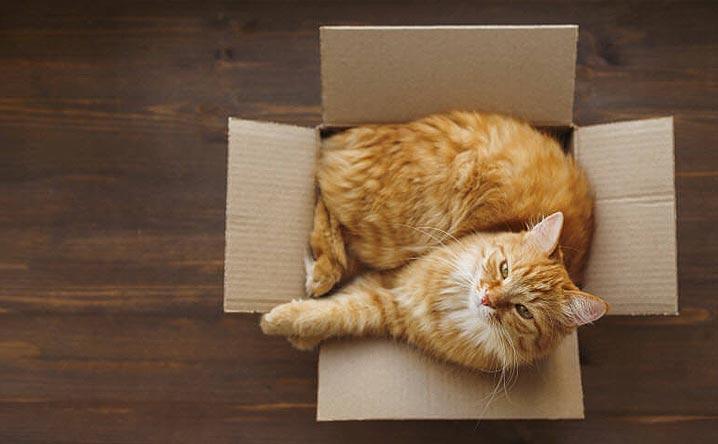The fact is that felines don’t like change. Just trying moving their water dish or their bed and see what happens! So, moving your home can take things to a whole new level. To help you make the transition as stress-free as possible – for both you and your furry loved one – we offer these suggestions:
First and most importantly:
Update your cat’s microchip and pet tag information. Cats can be escape artists and a cracked door or window provides just the motivation needed to zip away. Keeping your microchip registration updated will ensure you have the best chance for reuniting with your furry feline. Once that’s done, have your vet transfer records to the new veterinarian.
Prepping for the Move
Cat Carrier
Help your cat get use to the idea of the cat carrier. Begin by leaving it in a central location with the door open and a cozy bed inside. You can leave treats inside for your feline to discover on their own and then begin feeding your cat next to the carrier. Slowly, over a few days, move the food bowl right inside door. With each feeding, you can move the bowl further inside so at last the bowl is at the back of the carrier and your cat has to go all the way inside to eat/drink. Each cat is different, so patience is required.
Moving Boxes
Cats have an uncanny sixth sense of when “things are up.” Setting out your moving boxes at least a few days before you begin packing provides your feline with an opportunity to see, smell, feel the boxes and get used to them. If your cat is extremely skittish, you can secure them in an away room while you box up your belongings, particularly if you think your cat will try to hide within one of the boxes. Make sure your away room has a litter box, food, water, fresh air, and favorite toys.
Maintaining a Routine
Do your best to stick to the cat’s daily routine – feeding, playtime and downtime/sleep routine. If you have a overflowing schedule you might look into an automated feeder with timer.
Day of the Move
Away Room
Place your cat in an away room (with food, water, litterbox, bed, & toys) while movers are going in and out and moving your boxes and furniture. Remember to place a note on the door reminding everyone there is a pet inside and to keep the door closed.
Food, Etc.
Feed your cat a smaller than normal amount of food to reduce stomach upset but always have water available. If you have an extremely skittish cat, your veterinarian may want to prescribe a sedative.
Crate Your Cat
While you’re on the move, crate your cat to keep everyone safe. This goes for traveling by car, train or plane. It’s the best protection should their be major jostling about or an accident. And, cats feel safer in a confined space when they are in unfamiliar territory. Remember to include their normal food, a familiar blanket or toy, water in the crate, as well as towels for mopping up. Resist the urge to open the carrier to soothe your cat or it may try to escape.
For Long Distance Moves – pack a feline travel kit, including their favorite cat food & treats, their food & water bowls, favorite toys, a cozy blanket, and kitty litter, litter box and waste bag.
Maintain Your Routine
As we said at the outset, cats don’t like change. So, the fewer changes your furry felines have to endure, the better they will do. As much as you can, keep life as normal as possible not matter how chaotic life might seem for a while.
Settling Into Your New Home
Cat Proof Your New Home
This means filling any openings to crawl spaces or other areas where a cat could get stuck, tucking away electrical cords, securing screens on windows, and confirming that no pest control poison traps have been left anywhere in the home.
Temporary New Home Base
Set up a small, safe space for your cat to remain for the first several days until they feel comfortable. It should be quiet and less chaotic, such as a laundry room or spare bedroom. This allows for gradual acceptance of sights, sounds and smells while still feeling safe. Before you open their carrier, set up the room with access to food, water, litter box, bed, favorite toys, and fresh air.
Remember to place a note on the door reminding everyone the kitty is inside and to keep the door closed.
Important – spend time with your furry feline in this temporary home base – give them attention and spend time playing with them.
Introducing Your Cat to Their New Home
Gradually introduce them to other rooms in your new home while keeping other doors closed. How quickly you open up the rest of your home for exploration depends on your cat’s personality. If your feline is fearless, you can let them explore more freely. If more timid, go slow and gradual with the transition.
Gradually move their litter box from the home base location closer each day to what will be its permanent location.
Provide you cat with vertical adventures like cat trees, stacked boxes or window perches.
Your cat should settle in just fine and discover that their new home is just as safe & loving as their old home. It just takes a little planning, patience and understanding.
Here’s to a purrrrfect move.
If you happen to be moving with a dog, check out our blog post: Moving with Dogs





